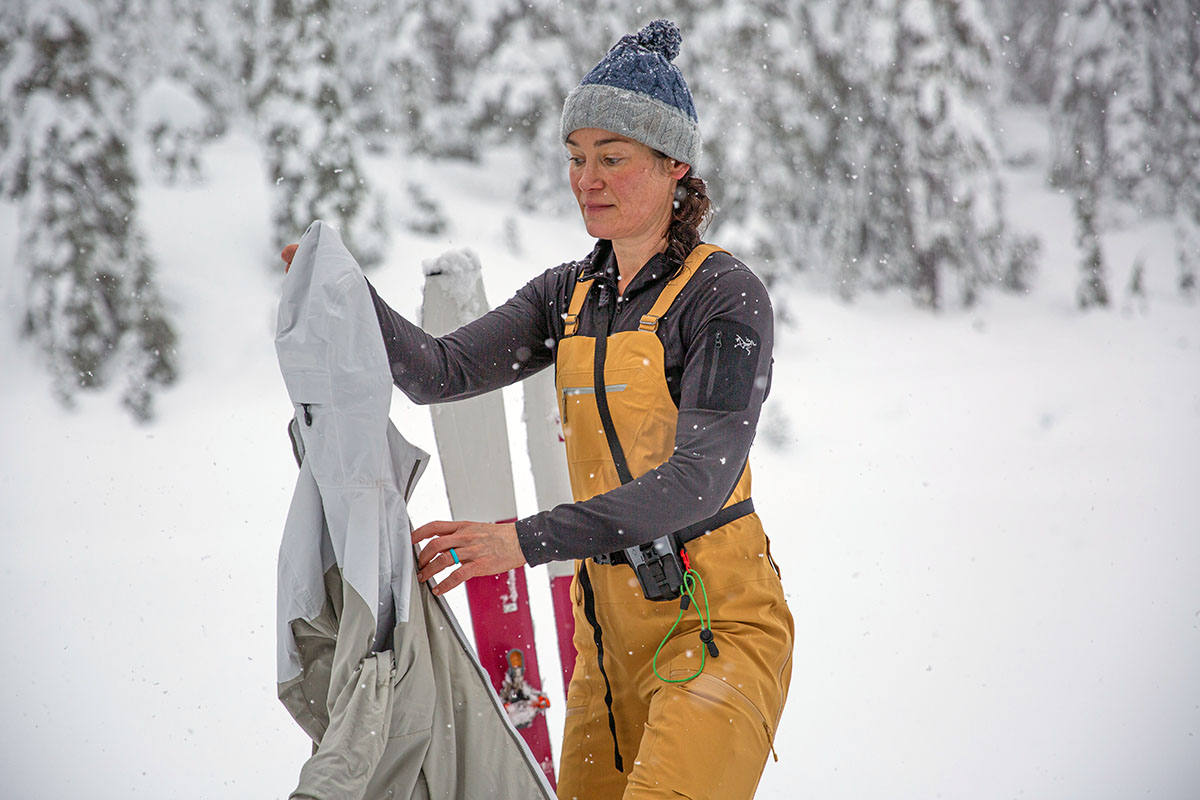

Price: $700
Waterproofing: 3L Gore-Tex
Weight: 1 lb. 4.4 oz. (size 4)
What we like: Proven Gore-Tex protection and high attention to detail in a light and streamlined package.
What we don’t: Expensive, surprisingly trim fit, and no built-in stretch.
See the Women's Sentinel Bib Pant See the Men's Sabre Bib Pant
Arc’teryx is a leader in the technical backcountry ski market, and their Sentinel Bib Pant (and men’s Sabre Bib Pant) slots in as a highly protective and tough design at a very competitive weight. With a mix of weather-ready Gore-Tex and a light flannel backer for added comfort, the Sentinel impressed us with its impervious feel and high attention to detail. The bib doesn’t come cheap at $700, and sizing runs noticeably small, but all-around performance is excellent for serious riders who spend a lot of time in the mountains. Below we detail our experiences with the Sentinel Bib Pant. To see how it stacks up to the competition, see our article on the best women's ski bibs. And to complete your kit, we've also tested and reviewed the Arc'teryx Sentinel Jacket.
Editor's note: Arc'teryx updated the Sentinel Bib for the 2024-2025 season, with the biggest changes being the transition to Gore's latest—and more eco-friendly—ePE membrane, swapping the thin flannel backer for Gore's similarly soft C-Knit backer, and incorporating more sustainability measures. We haven't had a chance to test the latest Sentinel Bib yet but will update this review with our feedback once we do.
Boasting a thick and proven 3-layer Gore-Tex build, durable water repellent (DWR) finish, and high-coverage bib design, the Arc’teryx Sentinel Bib Pant is a stalwart in wet and windy winter weather. I’ve worn the bibs on several socked-in resort days at Mount Washington, as well as multiple outings into the Mount Baker backcountry in highly variable conditions. Through it all, my baselayers have remained perfectly dry, and the Sentinel has effectively shrugged off everything Mother Nature has thrown its way—from wet sleet to pelting snow and torrential rain. I’ve also taken a few falls in deep powder, and the high torso coverage has been adequate to keep snow out, even when I wasn’t wearing a jacket. Finally, the thin flannel backer is perfect for taking the sting out of frigid days. It’s not thick enough to replace a baselayer but adds a modest dose of warmth and has a soft, cozy feel against the skin.
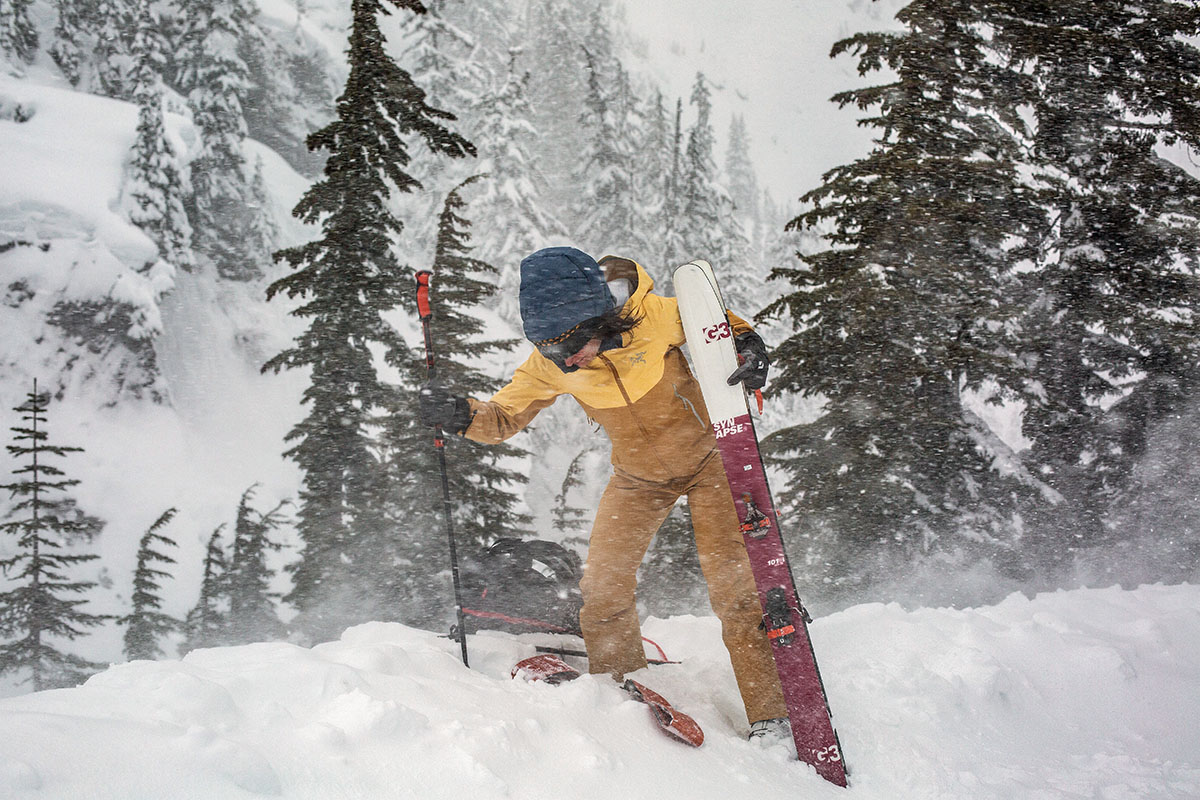
To help seal out the elements, Arc’teryx equipped the Sentinel Bib Pant with a few key features. First, all of the zippers are highly water-resistant—I trust them enough to carry my phone inside, but those concerned about moisture can secure electronics in a Ziploc bag for added assurance. The bibs also boast tough internal gaiters that nicely secure around ski boots and prevent snow from entering at the cuffs. Finally, as I touched on, the Sentinel inherently offers better protection than traditional ski pants because of its higher-riding bib design, which provides great coverage for deep powder, those prone to falls, and skiers who run particularly cold.
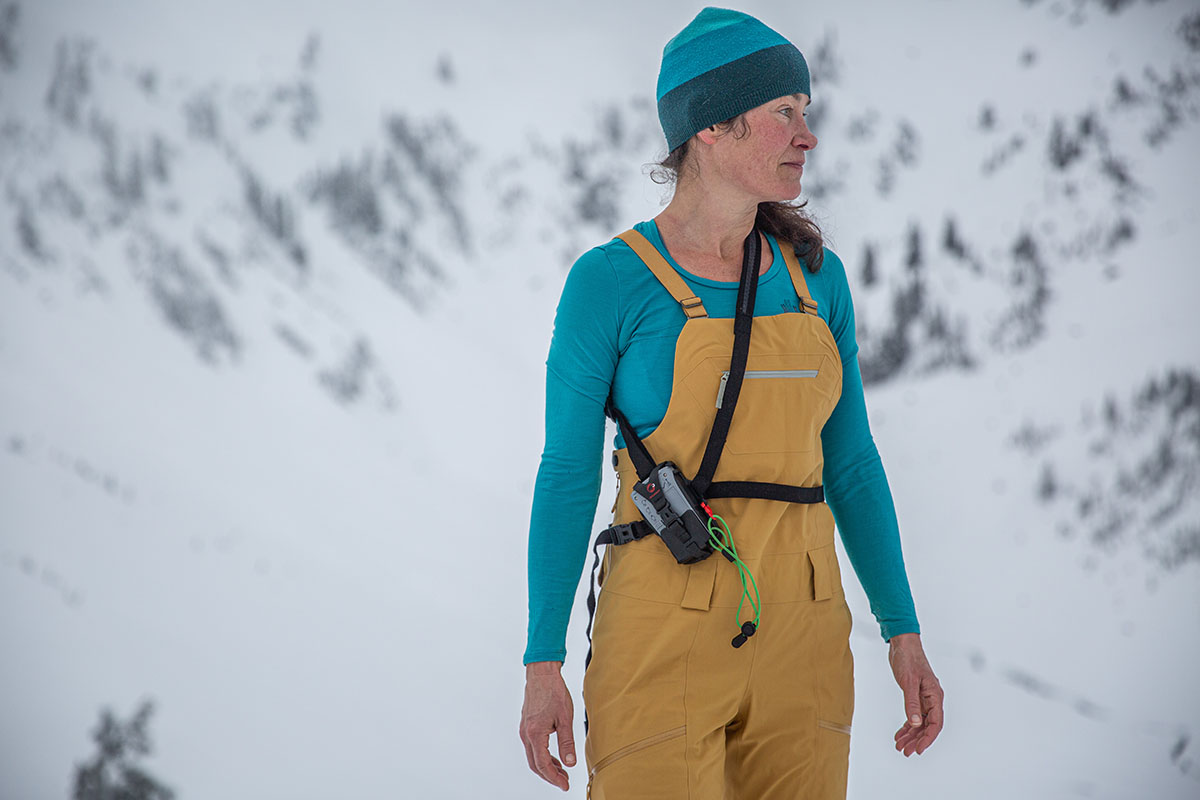
Given the thick Gore-Tex build and flannel backer, it wasn’t too surprising to learn that the Arc'teryx Sentinel Bib Pant can't match a softshell in terms of breathability. However, like most backcountry-focused designs, the bib comes equipped with two-way side vents, which are very effective at dumping excess heat. On the right side, the zipper extends all the way to the waist—and boasts a third zipper so that the side can be opened top-down for bathroom breaks—which promotes even more airflow if needed.
For full transparency, my legs typically don’t overheat when I’m exerting (except in warm spring conditions), and I tend to regulate my temperature by removing layers from my upper body instead. That said, I have come to appreciate the side vents on the Sentinel, and the flannel backer does an admirable job at wicking moisture. Those who run particularly hot might prefer a lower-profile, non-bib pant design, or consider opting for a true softshell model instead (if you can sacrifice wet-weather protection). But all in all, I’ve found the Sentinel to be perfectly serviceable for regular, high-output backcountry use.
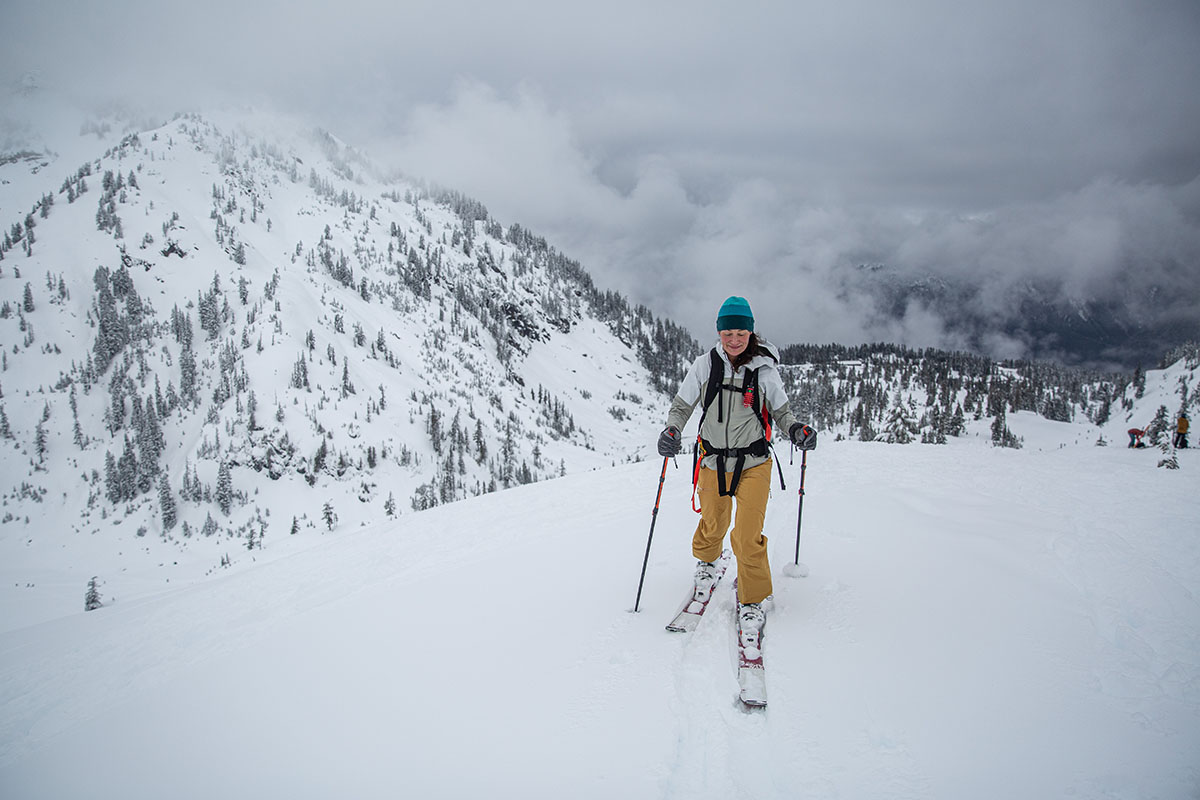
The Sentinel Bib Pant is plenty comfortable for long days on the skin track or at the resort—as long as you nail the fit. Overall, the Gore-Tex build is relatively supple and lacks the stiff and crinkly feel of many traditional 3-layer hardshells, and the thin flannel backer adds a nice dose of next-to-skin softness. And Arc’teryx outfitted the Sentinel with a gusseted crotch and articulated patterning that allow for good all-around mobility, although I think they could have taken it a step further by integrating stretch into the fabric (like what you get with Outdoor Research’s Skytour AscentShell Bibs or Flylow Gear’s Foxy Bib). The suspenders can also be adjusted but were a little too short for my 5’8” frame in a size 4. I haven’t had any issues with the bibs riding up uncomfortably, but they do tug a little when I raise my arms. If I had to buy the Sentinel again, I’d likely go up to a 6 to maximize overall comfort and freedom of movement (more in “Fit and Sizing” below).
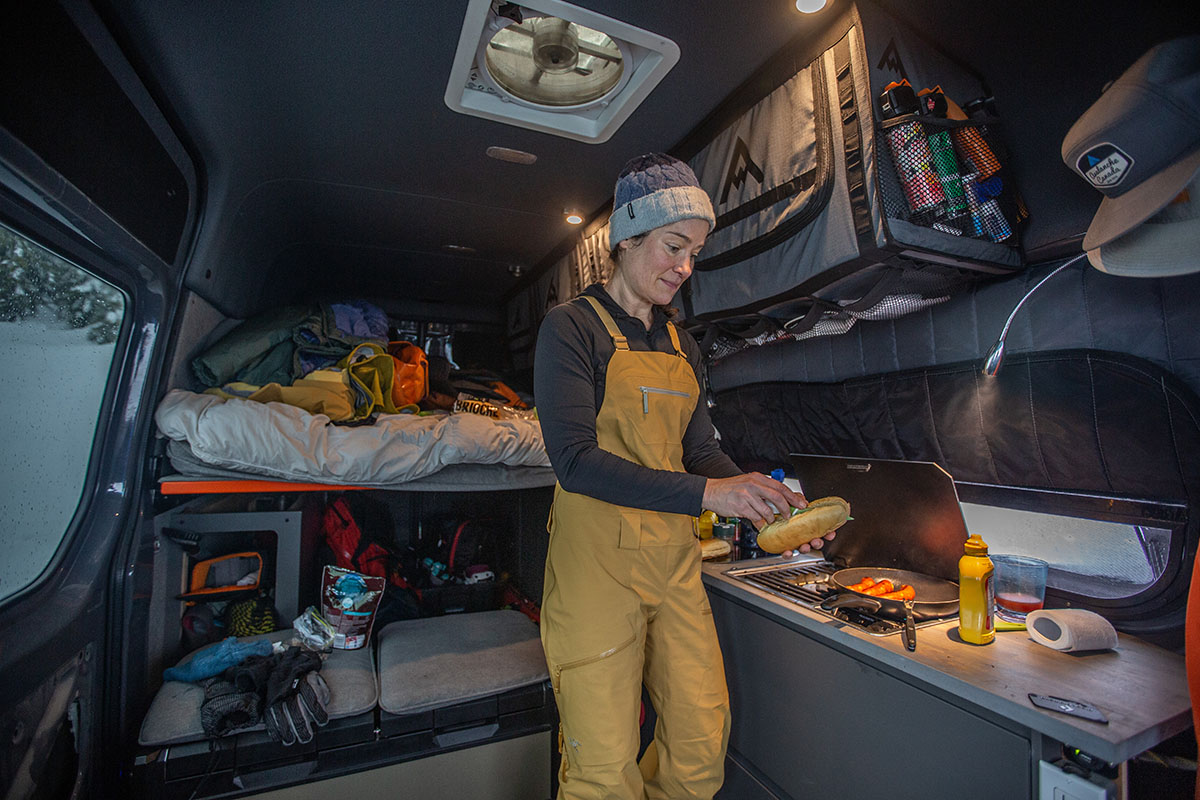
We’ve come to expect top-notch quality from Arc’teryx, and the Sentinel Bib Pant didn’t disappoint. The entire design is noticeably robust and confidence-inspiring, with 70-denier (D) Gore-Tex covering most of the bib and 100D Cordura at the cuffs for added protection against sharp ski and avalanche gear. The Keprotec instep guards are also extremely abrasion-resistant and have remained damage-free despite exposure to ski edges and other backcountry equipment. And all of the smaller components are holding up equally well, from the WaterTight zippers to the clean seams and grippy elastic at the bottom of the gaiters. Added up, the Sentinel strikes me as another thoughtfully built and long-lasting Arc’teryx piece.
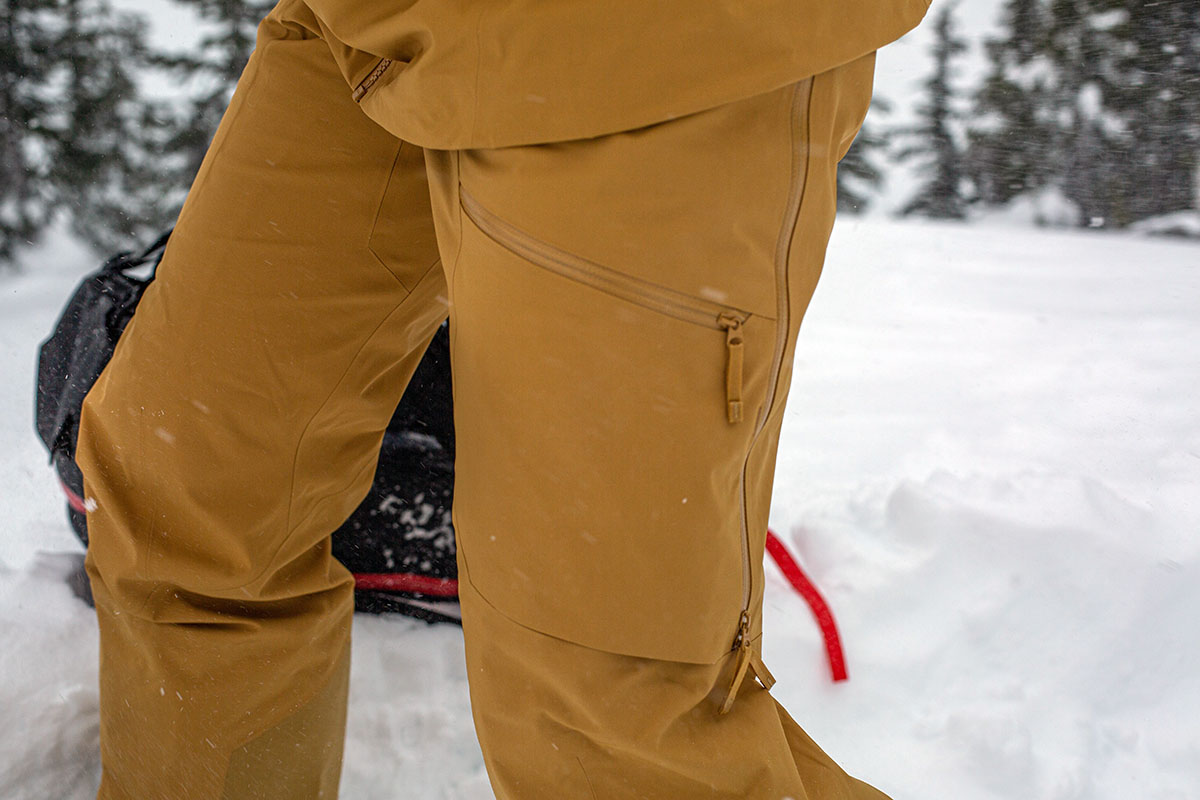
At 1 pound 4.4 ounces for my size 4 (they’re listed at 1 lb. 3.8 oz.), the Arc’teryx Sentinel Bib Pant is highly competitive in the wider women’s ski bib market. For reference, it’s lighter than similar designs like the Trew Gear Capow Bib (1 lb. 9 oz.), Outdoor Research Hemispheres II Bibs (1 lb. 5.5 oz.), and Flylow Gear Foxy Bib (1 lb. 6.9 oz.). Patagonia’s SnowDrifter Bibs (which are largely unavailable at the time of publishing) ever-so-slightly undercut the Sentinel at 1 pound 2.2 ounces, but they use a less weather-ready H2No construction that falls short of Gore-Tex in all-out protection. As expected, several lower-riding pant models also weigh less than the Sentinel, but I personally don’t mind the minor weight penalty for the added coverage around the torso.
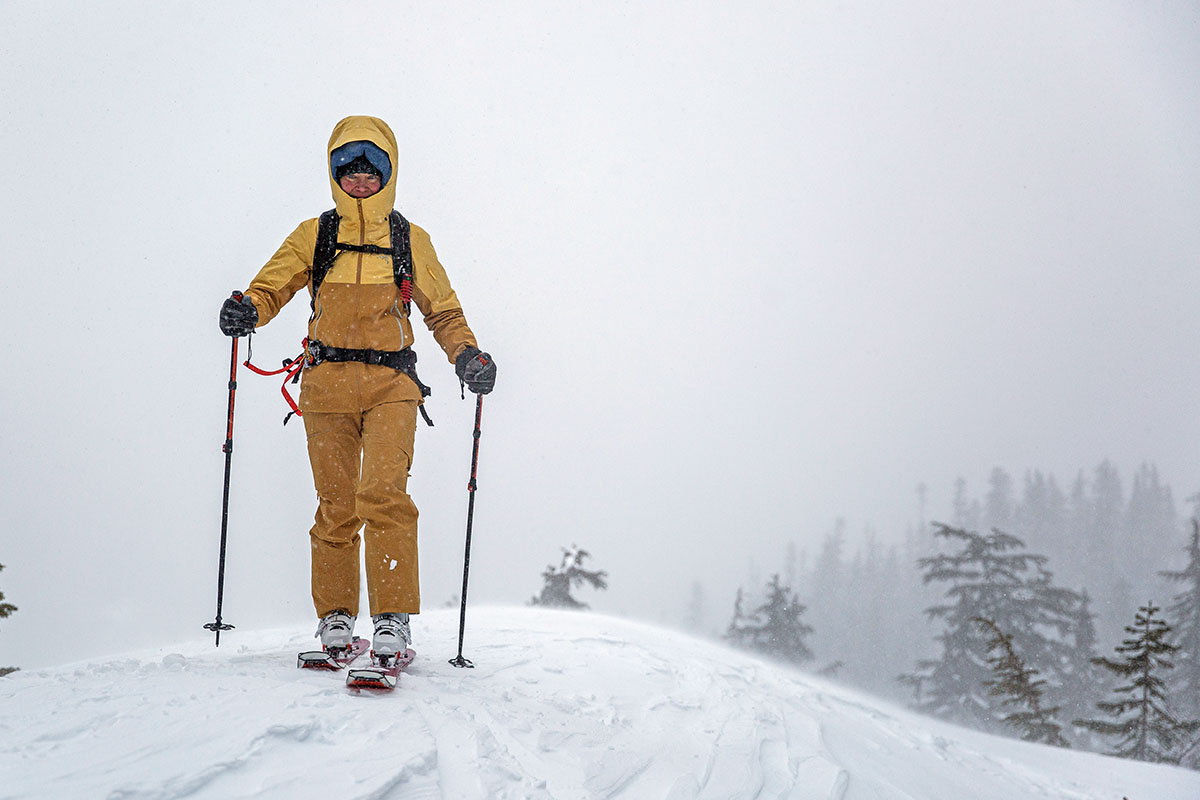
As I mentioned previously, the Sentinel Bib Pant boasts generously sized vents at the outer thighs for dumping heat quickly in warm weather. Overall, I found them to be very effective at promoting airflow. And for added convenience, the right vent is longer than the left and extends all the way from the thigh to the top of the bib at the torso, which makes it easy to slide the bib off for bathroom breaks. My only complaint is that the zipper on the right vent is a little sticky and requires two hands to operate (one to hold the fabric in place and one to open or close the vent), which is a little awkward but not a deal-breaker by any means.
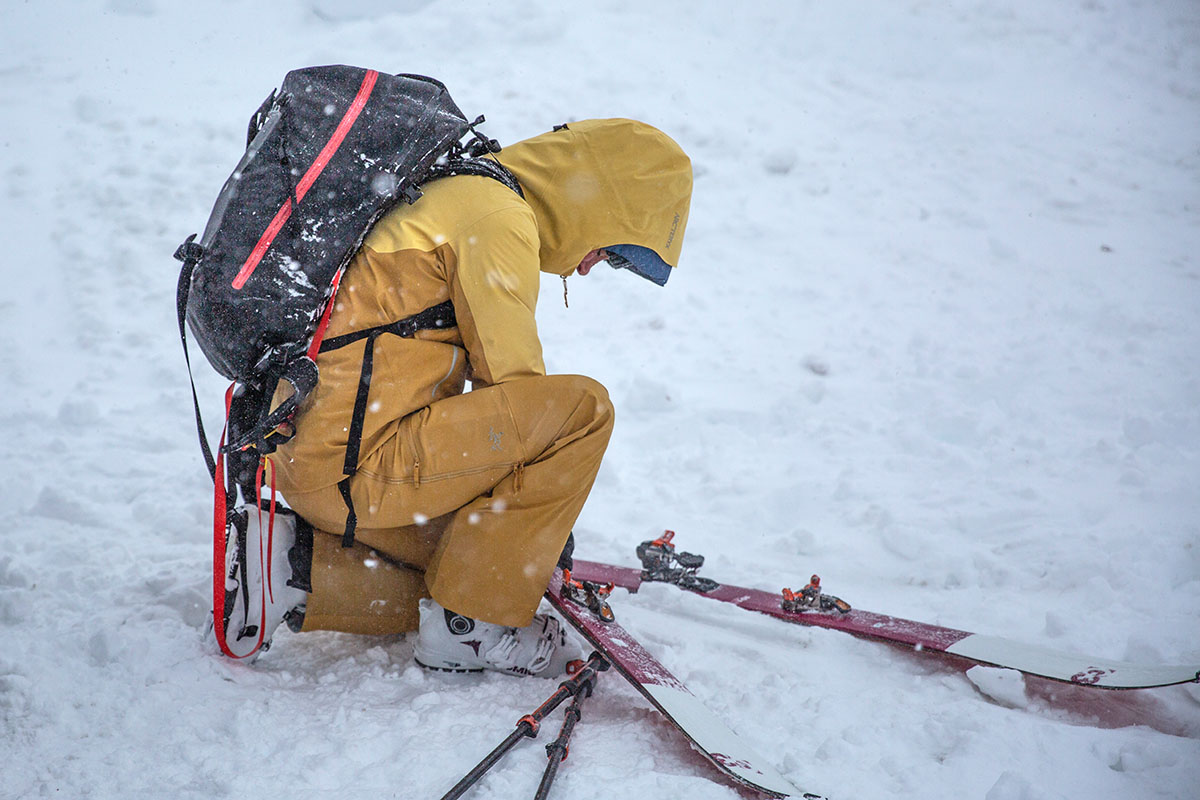
In terms of storage, the Sentinel Bib Pant comes adequately appointed for stashing the essentials with three total pockets. Starting at the top, there’s one small pocket at the upper torso for stowing small items like a credit card, buff, or lip balm. It also contains a handy key loop—not to be mistaken for a beacon loop, which Arc'teryx oddly left out. Rounding out the layout, you get a pocket at each thigh, both of which are nicely sized and can accommodate larger items like my plus-sized iPhone or Garmin inReach. The left also contains another key loop, while the right features a separate phone sleeve that easily swallows my iPhone 11. However, I’ve found that I need to be mindful of what I store in these pockets as any added bulk feels restrictive (more in “Fit and Sizing” below).
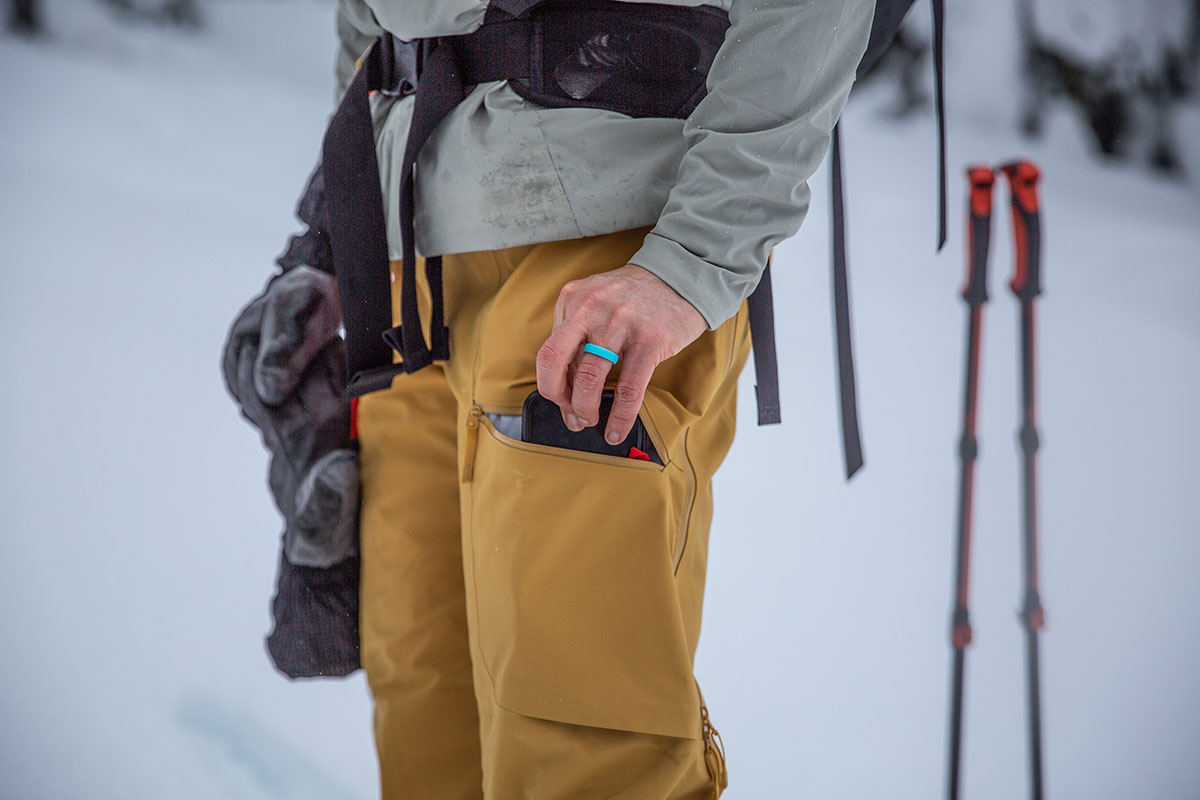
For sealing out snow at the ankles, the Sentinel Bib Pant features internal gaiters with integrated power strap slots, which Arc’teryx dubs their “TouringCuff.” The idea is pretty simple: A slot in each gaiter allows you to slide your boot’s power strap through so that you can tweak the fit without peeling back the entire gaiter. In theory, this is designed to make boot buckle management easier and quicker, but we’ve found that power strap slots take a good amount of time and dexterity to operate. That said, the gaiters have great elasticity for gripping onto ski boots even without a power strap holding them in place, and it’s easy to lift them up to make adjustments. As I mentioned above, they’re also noticeably beefy with 100D Cordura that’s highly resistant to tears and abrasion.
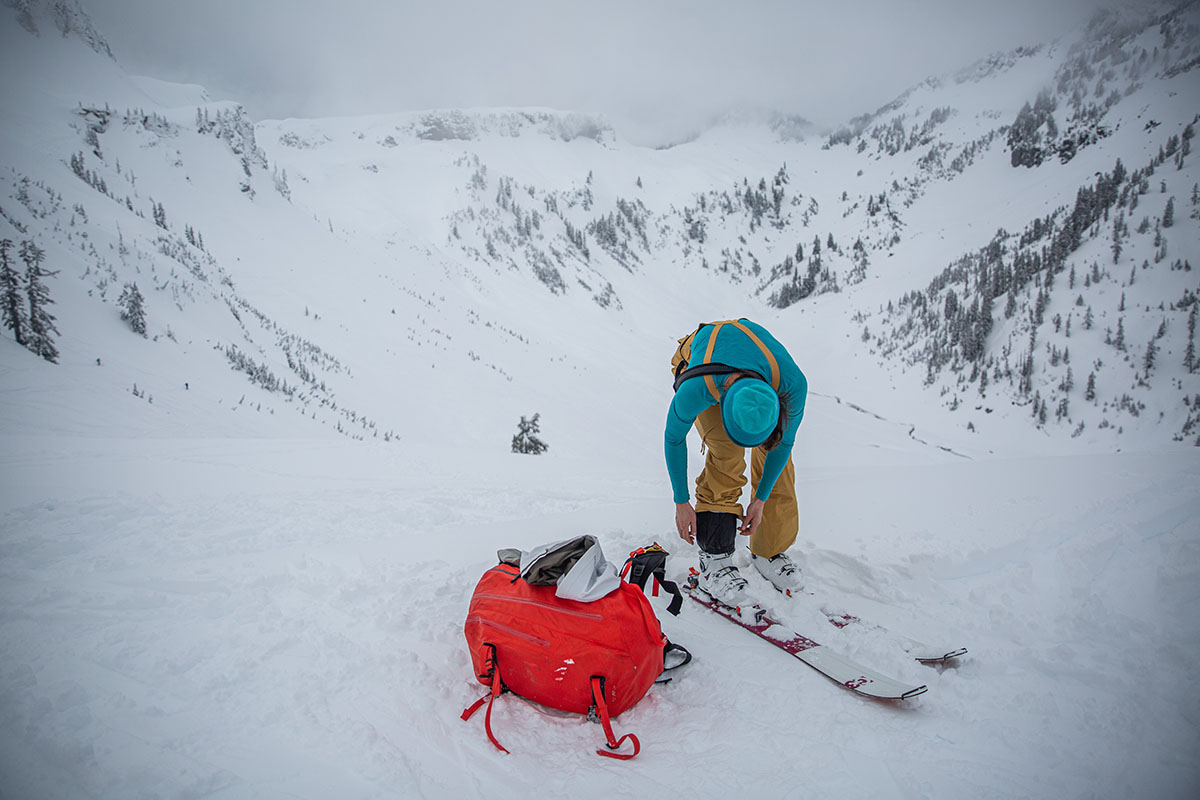
Arc’teryx labels the Sentinel Bib Pant as a “regular” fit, but I found that it ran much smaller than expected (Arc’teryx even calls this out directly in their “Size and Fit Tips” online). For reference, I wore a small in previous iterations of the Sentinel (I’m 5’8” and 130 lb.) with plenty of room to spare. However, Arc’teryx recently revamped their sizing and switched to a numerical system that offers more options (from 00 to 16) to accommodate a wider range of body types. Based on their sizing chart and my experiences with prior versions, I opted for a size 4 and expected to have ample room for layering underneath. Instead, the bibs are almost too tight. I can move around comfortably and bend down to adjust boots or ski bindings, but they’re snug enough that I’m not able to store anything bulkier than my phone in the thigh pockets. I do have fairly muscular legs, but I feel it’s a safe bet that most women will want to size up.
Like many other leading outdoor brands, Arc’teryx has been making continued improvements to their lineup in the name of sustainability. The Sentinel Bib Pant isn’t their most comprehensive effort to date, but we appreciate that they used bluesign-approved materials that have been deemed safe for the environment, workers, and consumers. We hope to see Arc’teryx incorporate additional measures like recycled fabrics or certification to the Fair Trade Standard in a future update, but we nevertheless applaud them for their efforts thus far.
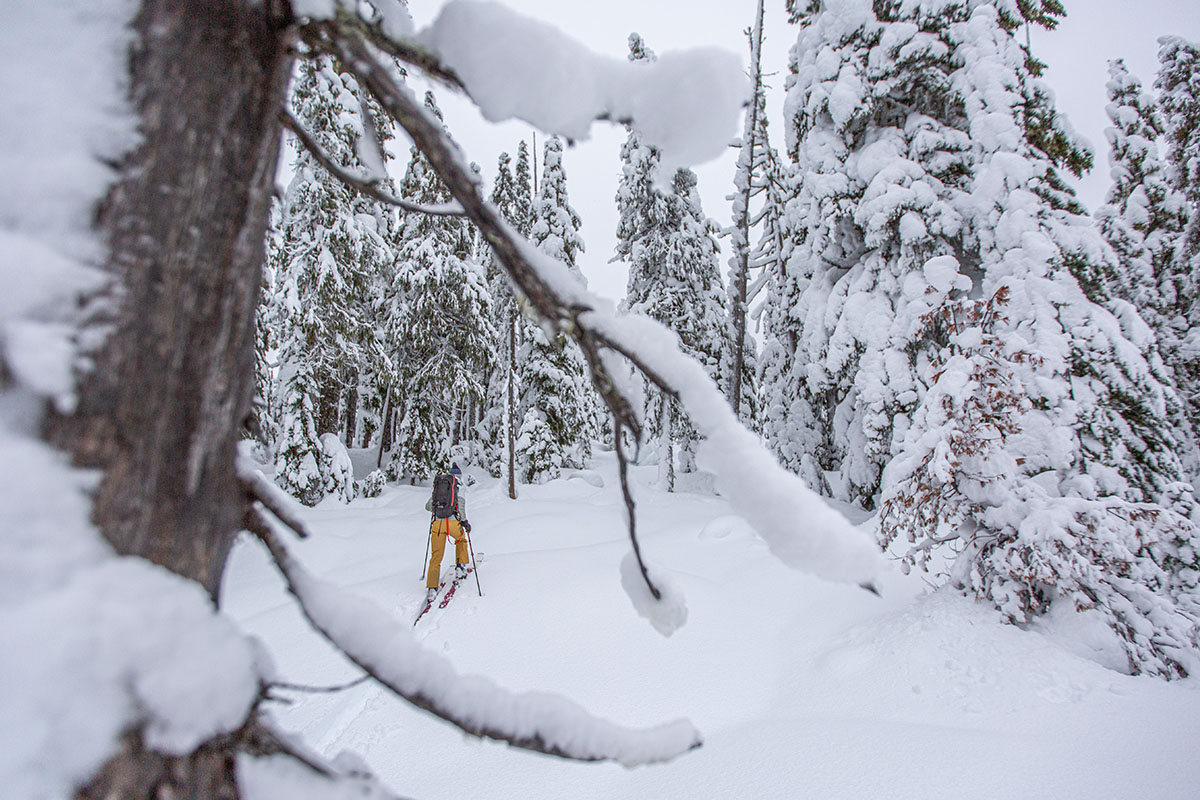
In addition to the bib version of the Sentinel that we tested, Arc’teryx also makes the design in a lower-riding pant variation for $550. The decision between pants and bibs comes down to a matter of personal preference, and whether the added coverage is worth the extra $100 is entirely up to you. Otherwise, the two share a nearly identical construction, including the same mix of materials, “regular” fits, and similar features (the pants have one fewer pocket and no dedicated phone sleeve). To complete your kit, Arc’teryx also offers the Sentinel Jacket (see our in-depth review here), Sentinel Anorak, Sentinel Insulated Jacket, and Sentinel One Piece. All share the same proven Gore-Tex waterproofing and the brand’s “regular” fit.
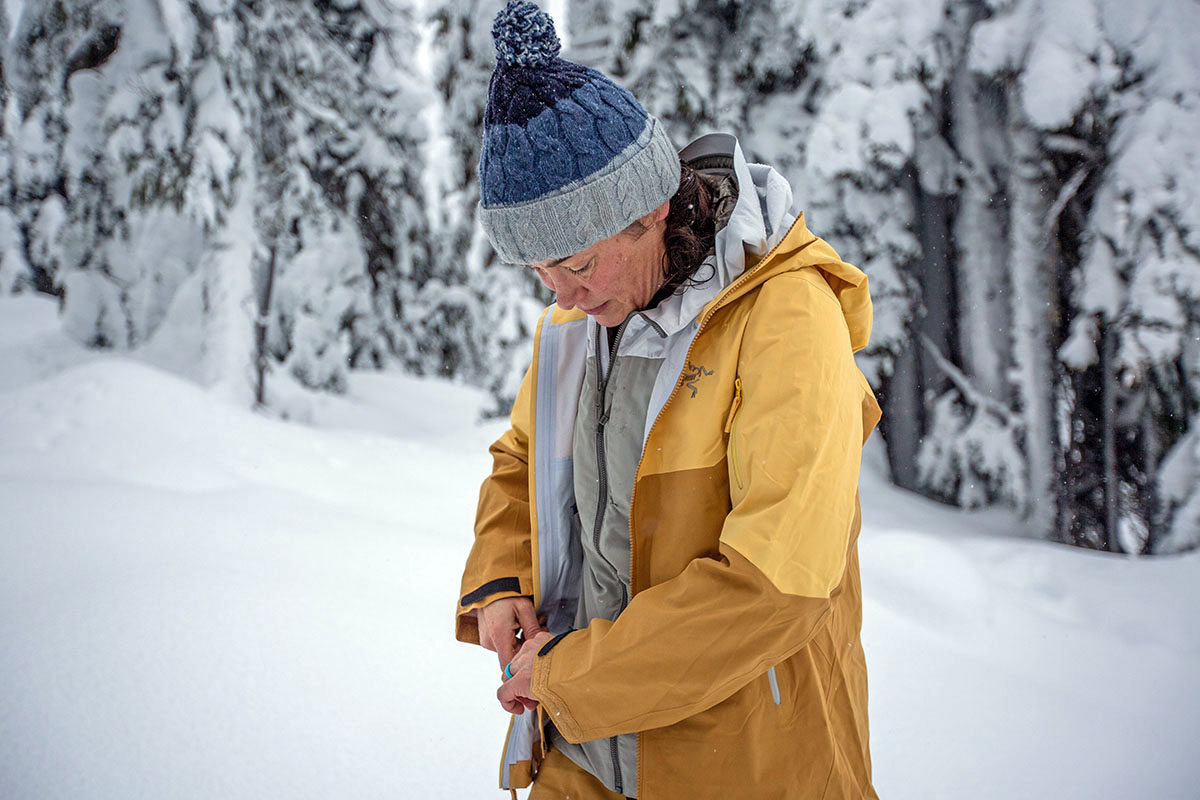
The Sentinel is a women’s-specific collection, and the men’s equivalent is called the Sabre. Like the women’s models mentioned above, the Sabre is offered in jacket, bib, and pant variations that cost the same as their women’s counterparts but weigh more and come in different colorways.
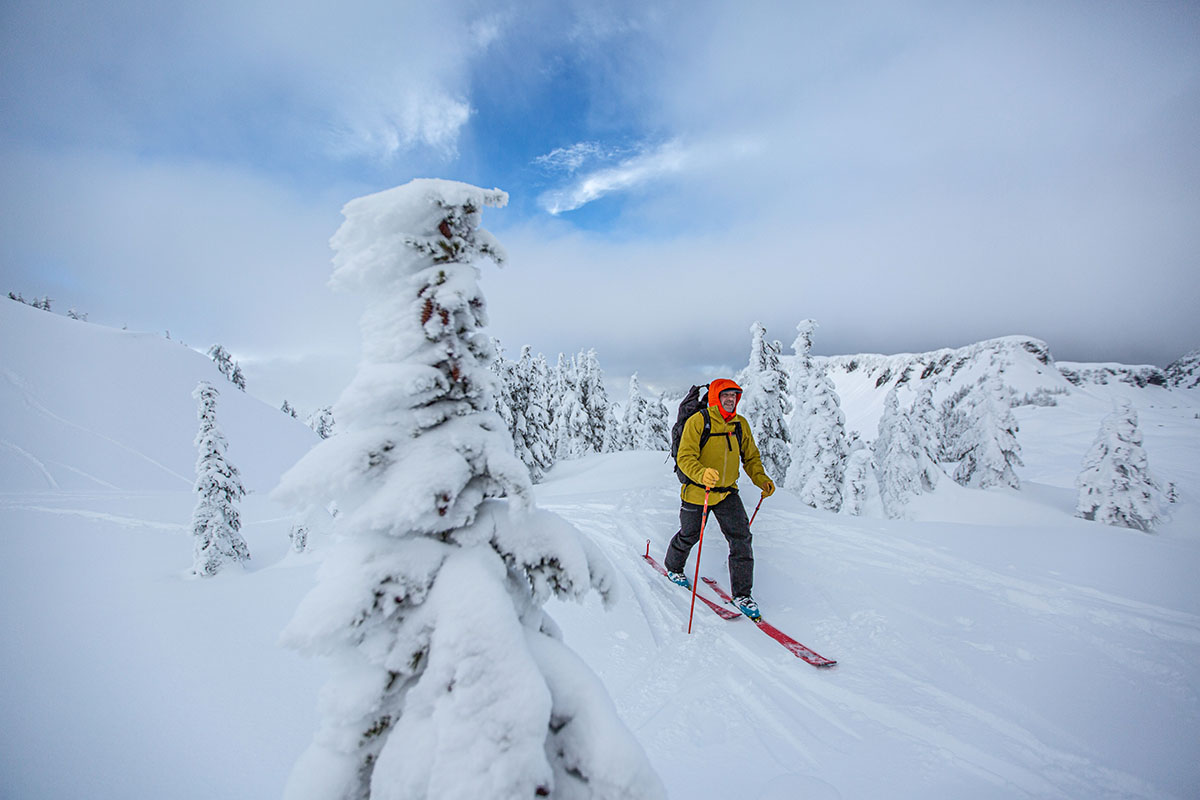
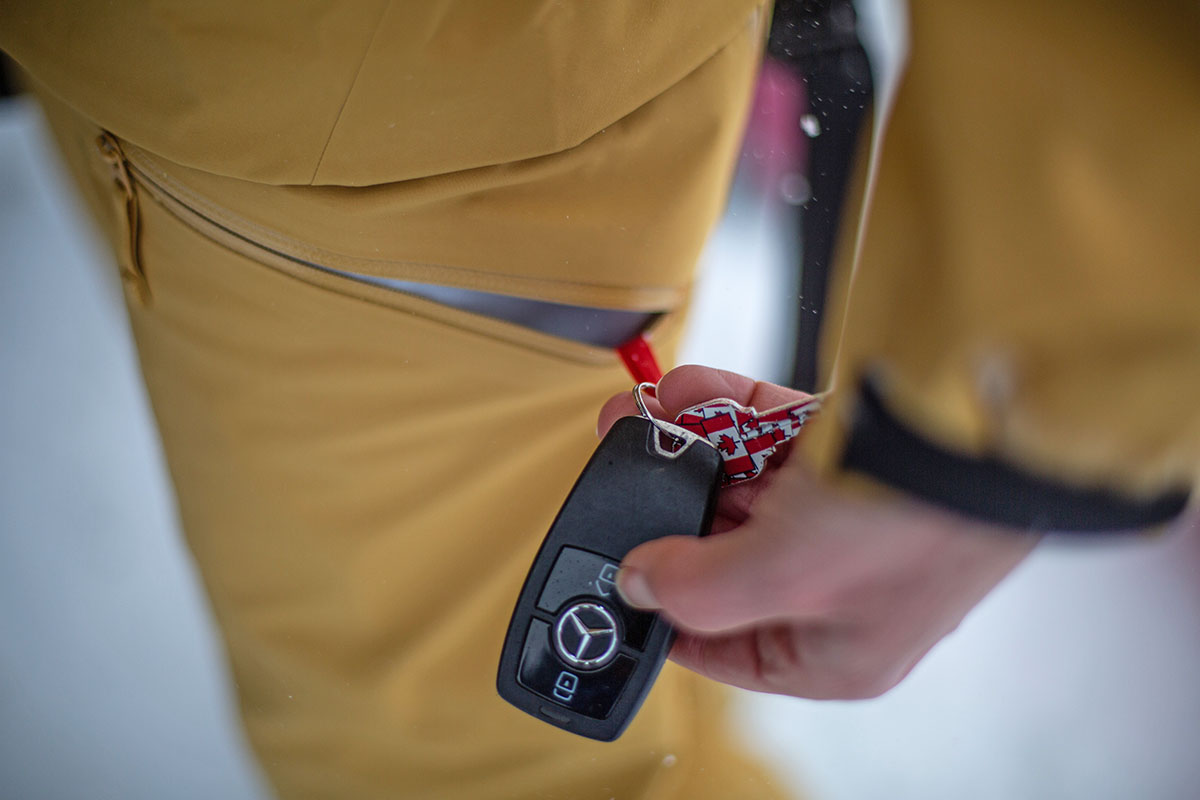
| Jacket | Price | Best For | Waterproofing | Fabric | Weight |
|---|---|---|---|---|---|
| Arc'teryx Sentinel Bib Pant | $700 | Backcountry | 3L Gore-Tex | 70D | 1 lb. 3.8 oz. |
| Arc'teryx Rush Bib Pant | $650 | Backcountry | 3L Gore-Tex w/ C-Knit | 80D | 1 lb. 3.9 oz. |
| Outdoor Research Skytour | $429 | Backcountry | 3L AscentShell | 40 x 65D | 1 lb. 7.6 oz. |
| Trew Gear Capow Bib | $549 | Backcountry/resort | 3L Dermizax EV | Unavail. | 1 lb. 9 oz. |
| Flylow Gear Foxy Bib | $430 | Resort/backcountry | 3L Tactic | 100D | 1 lb. 6.9 oz. |
Arc’teryx’s Sentinel Bib Pant is a tough and reliable freeride design for big-mountain days, but there are several other competitive women’s ski bibs to choose from. The first comes from within Arc’teryx’s own lineup: the Rush Bib Pant. For the same price and around the same weight as the Sentinel, the Rush is slightly more durable with an 80D build and tacks on Gore’s C-Knit backer for added next-to-skin comfort (both designs use a 3L Gore-Tex membrane for waterproofing). Like the Sentinel, the Rush also features 100D Cordura TouringCuffs, tough Keprotec instep guards, three total pockets, and generous outer thigh vents for dumping heat. The biggest downside is coverage: The Rush rides noticeably lower than the Sentinel, which is a boon for breathability but detracts from overall protection and warmth. In the end, we consider the Sentinel to be the better-balanced design, but the Rush offers similar overall performance for the same price. Note: Both bibs run noticeably trim, and many women will want to size up.
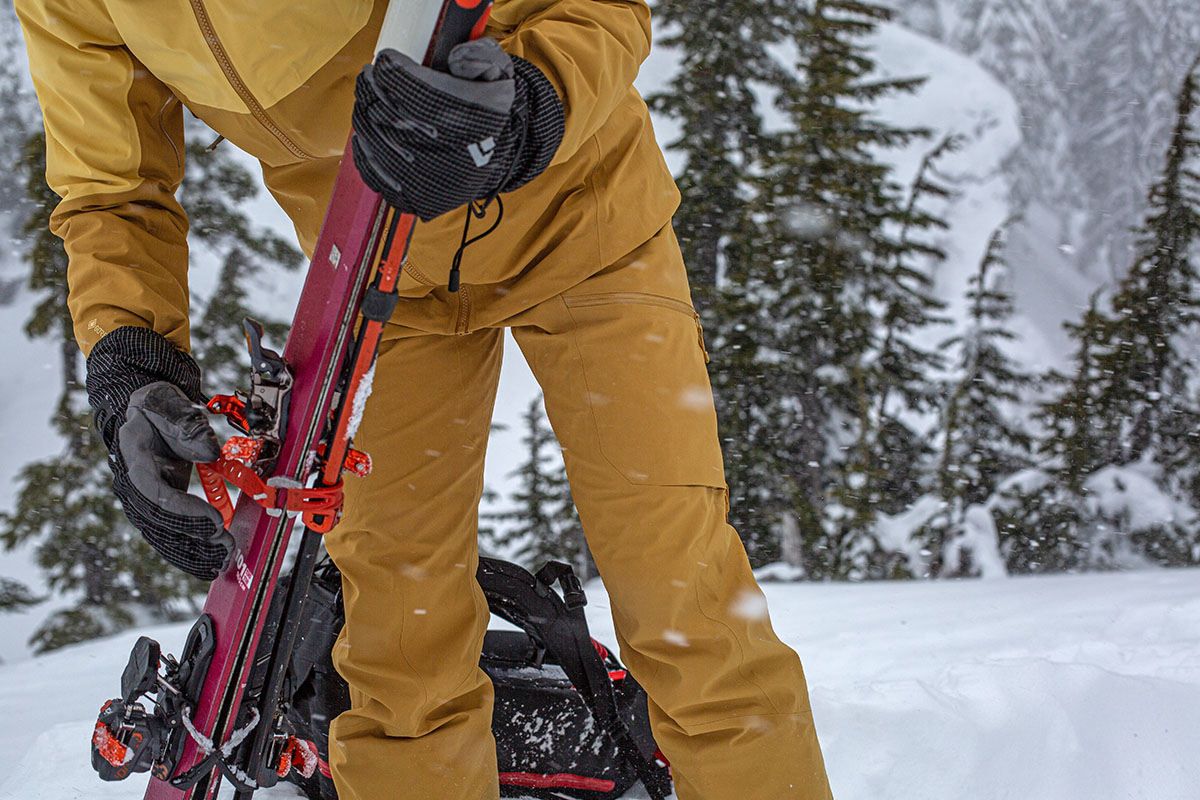
Moving away from Arc’teryx’s lineup, Outdoor Research’s Skytour AscentShell is our favorite backcountry bib this year. In short, it checks all the boxes we look for in a well-rounded touring design, including excellent mobility, breathability, and durability in a reasonably light (1 lb. 7.6 oz.) package. OR’s AscentShell fabric is the highlight here: It stretches, breathes, and is remarkably quiet without sacrificing wet-weather protection. The Skytour also includes stretch-woven softshell above the belt, along with a gusseted crotch and articulated knees that offer exceptional freedom of movement. Plus, you get a dedicated beacon pocket. In terms of downsides, the Skytour is relatively thin at 40 x 65D and much more air-permeable than the Sentinel (we often have to wear a thick baselayer underneath). But for a whopping $271 less than the Arc’teryx, the OR gets the clear edge in value and will meet the needs of most backcountry riders.
Next up is Trew Gear’s Capow Bib, which retails for around $150 less than the Sentinel. In this case, Trew opted for a stretch-infused hardshell fabric below the belt and stretch-woven nylon along the upper bib. Overall, the Capow is high on comfort, offers excellent mobility, and is both more ventilated and less restrictive than the Arc’teryx. We also love the handy drop seat for bathroom breaks and accommodating fit that works for a wider range of body types. That said, the stretchy construction sacrifices a little waterproofing compared to the Sentinel’s standard Gore-Tex build—it’s still no slouch, but it wouldn’t be our first choice for wet chairlift rides. It’s also heavier than the Arc’teryx at 1 pound 9 ounces and has a noticeably lower cut (similar to the Rush outlined above) that sacrifices a good deal of coverage. In the end, we’d urge committed riders to spend up for the lighter and more protective Sentinel, but the Capow is a great value for those who split their time between the resort and backcountry.
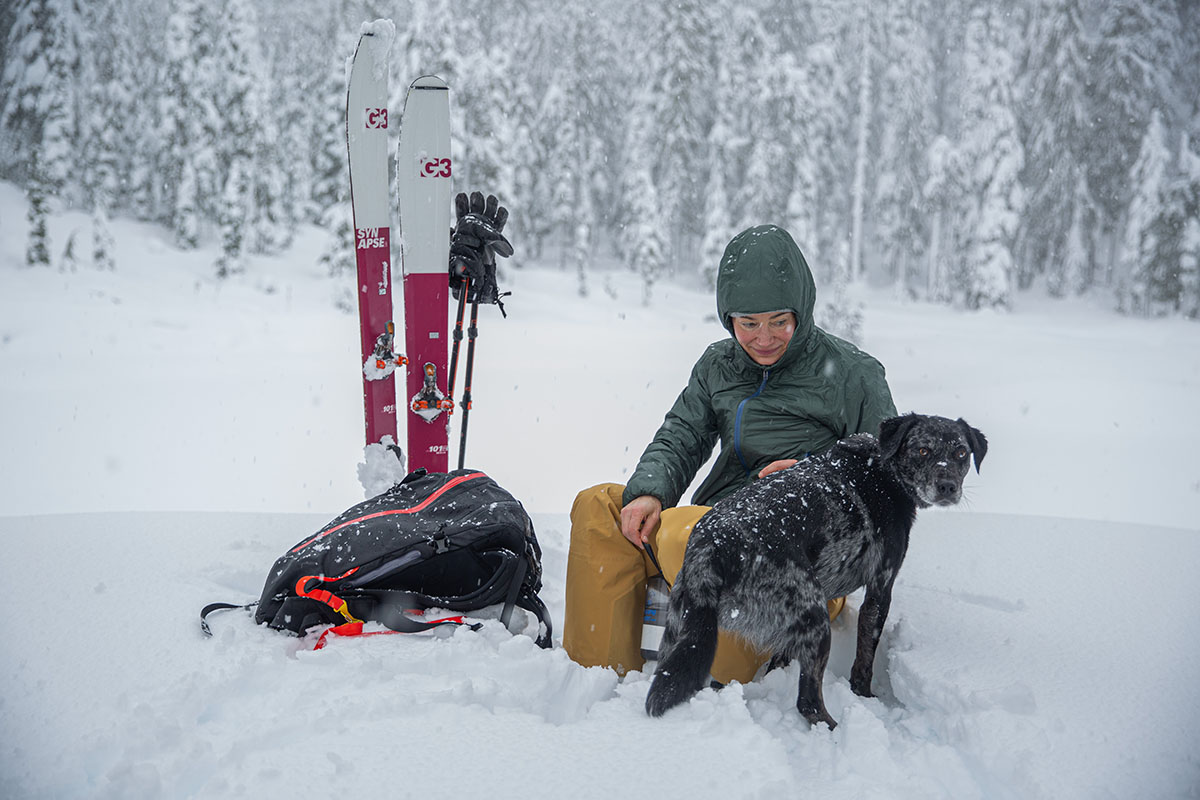
Last but not least, Flylow Gear is a backcountry and big-mountain specialist, and their Foxy Bib (and men’s Baker) is one of our longtime favorites. What makes it stand out? First, the bib is comfortable yet protective with a stretch-infused hardshell fabric (that’s also impressively durable at 100D), and the feature set is well sorted with vents on both the inside and outside of the thighs and no shortage of pockets. You also get generous gaiters with reinforcements at the cuffs, a “barn door” zipper for easy entry and bathroom breaks, and availability in three inseam lengths and a nice array of classy colorways. The biggest concessions are weight and protection: The Flylow checks in at a fairly heavy 1 pound 6.9 ounces, is a bit bulky for touring, and falls short of the Arc’teryx in waterproofing due to the stretchy construction (for more, see our in-depth Foxy review). But at a significant $270 less than the Sentinel, the Foxy is far and away the better value for resort skiers, casual backcountry-goers, and riders who double dip.
If you’re thinking about buying gear that we’ve reviewed on Switchback Travel, you can help support us in the process. Just click on any of the seller links above, and if you make a purchase, we receive a small percentage of the transaction. The cost of the product is the same to you but this helps us continue to test and write about outdoor gear. Thanks and we appreciate your support!
Depending on the seller, most products ship free in the United States on orders of $50 or more. International shipping availability and rates vary by seller. The pricing information on this page is updated hourly but we are not responsible for inaccuracies.